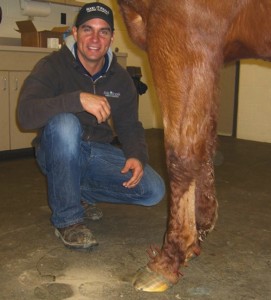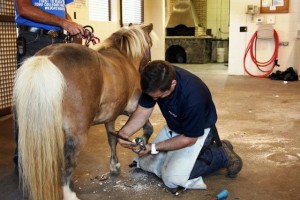
Photo by Lisa Lancaster, DVM, and courtesy of Fran Jurga’s Hoof Blog. A patient receives acupuncture
Dr. Raul Bras, DVM, CJF at world-renowned Rood & Riddle Equine Hospital is on the front lines of the daily battle to keep horses sound.
In another installment of a special Horse-Health Q&A series with OffTrackThoroughbreds, the podiatry expert answers questions about the dreaded disease, laminitis.
Bras points out that the affliction, which led to the demise of racing greats Secretariat and Barbaro, stubbornly remains the second leading cause of death of horses.
Here, the respected Rood &Riddle veterinarian, a 2005 graduate of Ross University School of Veterinary Medicine, answers questions about advances in treatment, and also offers a cautionary opinion to those who would seek to cure laminitis by removing their horse’s shoes.
In addition to Bras’ veterinary credentials, he is also one of a handful of veterinarians in the United States to earn a Journeyman Farrier certification from the American Farrier Association. He is a graduate of the Cornell University Farrier School as well.
Q: Laminitis is still very much in the news. Would you say that awareness of the condition is continuing to grow? And, if so, to what would you attribute this?
Laminitis remains the second most leading cause of death in horses after colic disease. Therefore, the awareness of the condition continues to grow, and it is mostly attributed to the continuing education focusing on this devastating disease.
Veterinary practitioners have been paying more attention to try not only to prevent the disease, but also on ways to manage horses presenting with signs of laminitis.
Additionally, over the past couple of years, the vet-farrier relationship has been improved, and continues to be considered as an imperative factor in the treatment of the laminitic horse.
Recently, veterinary schools have been incorporating podiatry courses into the clinical programs to teach the upcoming veterinarians students the importance of laminitis in their daily practice.
Q: What have been the greatest advances in the medical treatment of the disease? And, have advances led to a higher survivor rate?
The greatest advance in the medical treatment of the disease has been the use of cryotherapy (icing the feet) with horses in the early stages of laminitis. The treatment is done to ameliorate some of the devastating consequences of the diseases.
Also, the increased awareness of the condition, combined with a better understanding of the different types or stages of laminitis, has allowed the practitioners to approach the horse as an individual case. This has resulted in more accurate diagnoses and therefore, a better treatment protocol. Ultimately, these developments have led to greater technological and medical advances, which allow us to gain a better understanding of the process of laminitis.
Stem cell therapy has also been proposed as a promising adjunctive therapy for laminitis but this is still in research stages.
Q: I understand that there are many new treatments being developed to help increase circulation to the hoof. Is there any one that stands out as being among the best?
Drug therapy to increase the circulation of the hoof remains questionable.
Vasodilators (which dilate blood vessels) such as acepromazine, pentoxyfilline, ixosuprine, and aspirin have been recommended with poor results.
We have to keep in mind and understand that when the horse has a mechanical failure of the hoof/coffin bone (displacement), the circulation of the horse’s feet is compromised.
This could be assessed and evaluated with the use of venograms (imaging) where contrast material is injected into the vein outlining any perfusion deficits on radiographs. Therefore, I believe that therapeutic shoeing addressing the bone displacement / angle will allow the foot to reperfuse overtime.
Q: On the opposite end of the spectrum, I have also spoken with owners who have removed the horse’s shoes in a last-ditch effort to heal the laminitis, and some indicate that it has seemed to work. Do you ever recommend this approach?
Leaving the horse with signs of laminitis and evidence of any type of mechanical failure (displacement) barefoot is a misconception that should be clarified with educated information.
In my opinion, any type of medical or pathological process, and evidence of mechanical failure (displacement) should be treated and supported to allow the horse to heal, appropriately preventing further displacement and deterioration.
As practitioners we must understand the anatomy and the forces that are involved in the process of laminitis so we can treat these cases as required. How would you feel if you broke your foot, and your doctor tells you not to worry about it, take your shoes off, continue to walk barefoot, and hopefully you will get better? My guess is that you won’t appreciate that recommendation!




I have a 9 yo TWH mare that i use for trails mostly (and the occasional show) who had a VERY mild case of laminitis about 5 years ago. She got too overweight from the grass in the spring and got sore, luckily we caught it early. Not sure what kind of rotation has gone on but she hasn’t been lame since then and she has the smoothest gait. Her hooves are dry and starting to chip now and I’m thinking of getting shoes on her for protection from chipping on the hard ground and the riding that we do. Happy to say i have an appointment with Dr. Bras in about a week or two 🙂
What is the link between Trama and Laminitis? Why when a horse has some type of trama, it is more prone to Laminitis? Once they have Laminitis, will the have it the rest of their lives?
Hi Laura,
Thanks for writing in to my blog. That’s a great question! I don’t know the answer, as I am merely the blogger and writer. But, inspiration has struck! If I get more followup questions, I’ll try to get them answered. Rood & Riddle has been tremendously gracious to accept my Q&As in the first place, so, I won’t look a “gift horse” in the mouth and ask too much. 🙂
I also wonder if some of the readers of this blog might have some insights or experiences they can share.
I know to each their own theory and practice, however in our case, going barefoot was hands down our saving grace, from laminitis. That being said, my horse is not IR and therefore he didn’t continue to founder, but the damaged that was done to his hooves in shoes was beyond shocking. I would love a vet to do research/studies on cases to see which in the end resulted to a more sound life after the fact of rotation; shod or bare. I’m a betting girl that the barefoot horses recover for a healthier hoof long term vs shod. Not to cause any controversial discussions here but there is so much being done to help people in the barefoot world, and I don’t know why more vets do not look into that as a source of therapy, or at the least, a discussed option.
Kristen,
Your story about your horse’s recovery, and the shoe removal component, should be chronicled and submitted to vets like Dr. Bras. I bet he would love to hear about your success, and maybe there is something special about your case that would help inform the larger veterinary circles about the terrible disease. You never know.
I still get goosebumps when I think about your particular story, and how well your OTTB recovered.
Thanks for writing in!